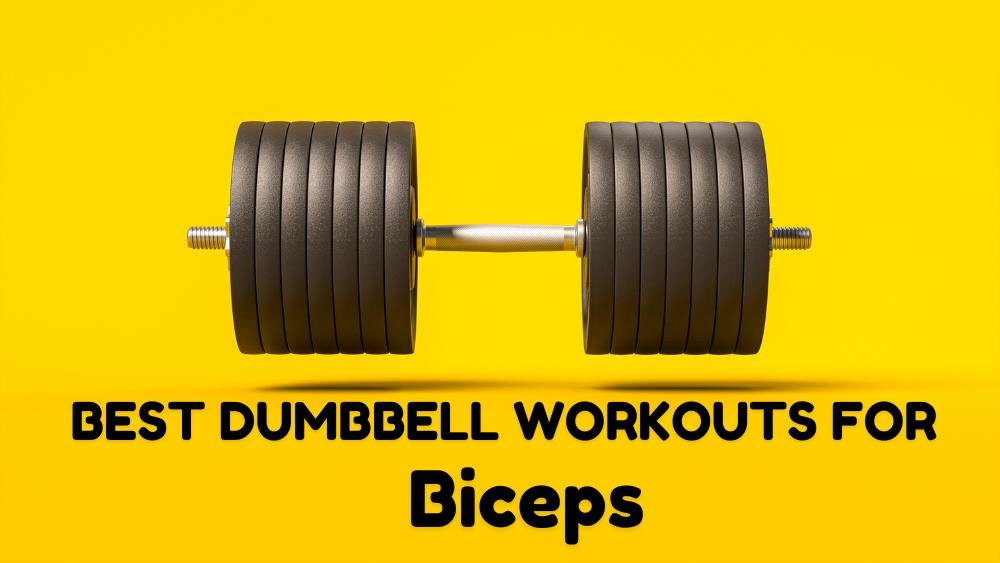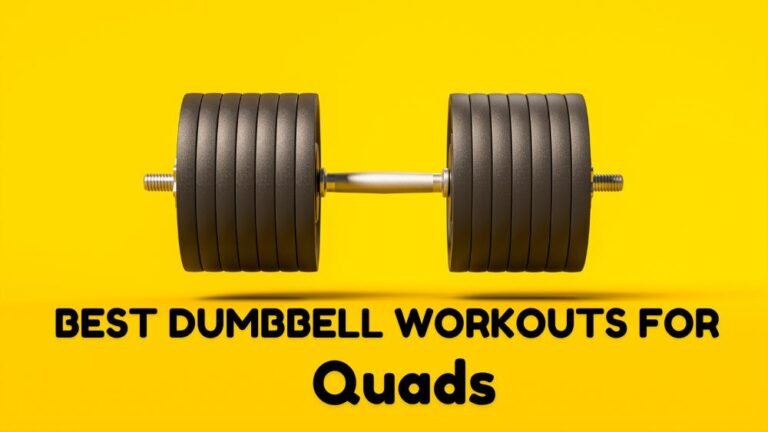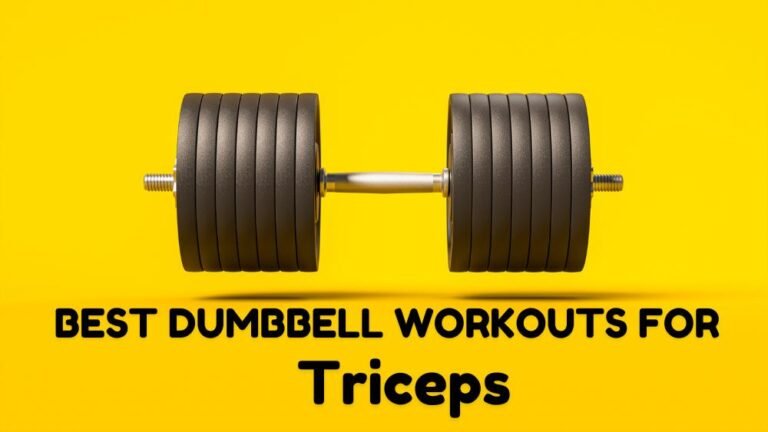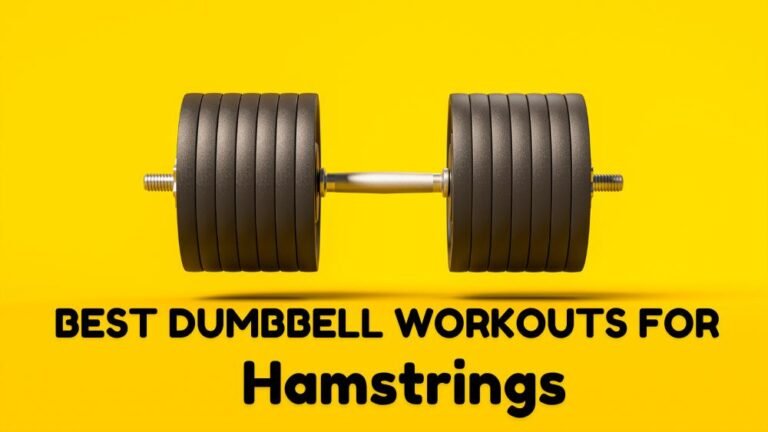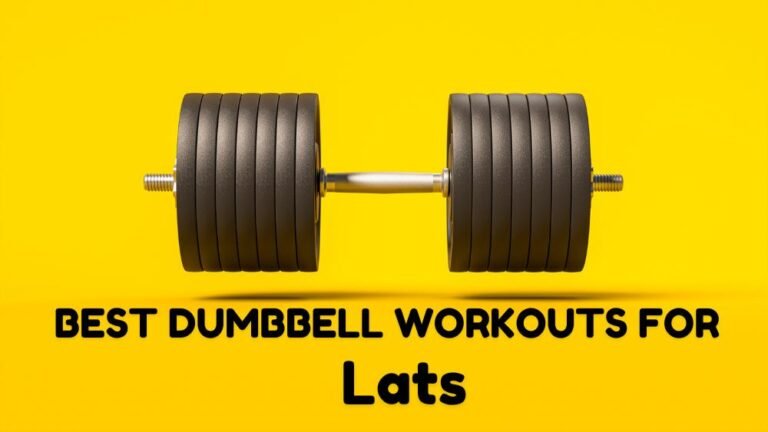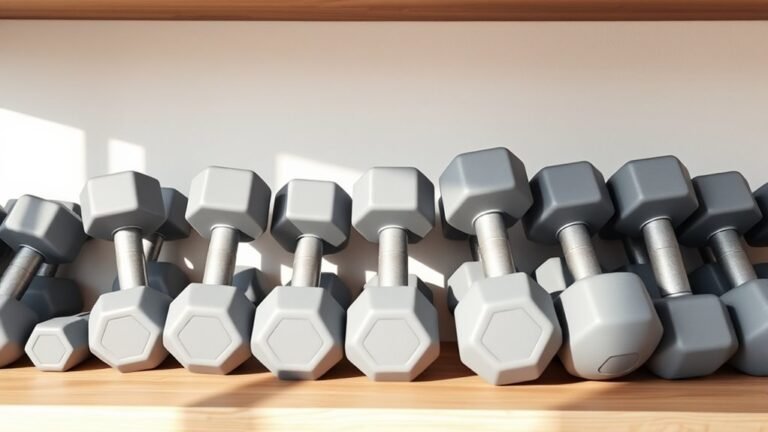14 Best Dumbbell Exercises for Sculpting Strong Biceps
Building strong biceps is a common fitness goal for many individuals, whether you’re a seasoned athlete or just starting your workout journey. The biceps, located on the front of the upper arm, play a vital role in various daily activities and physical movements.
Not only do well-defined biceps enhance your overall physique, but they also contribute to better performance in sports and functional strength.
In this guide, we’ll explore the benefits of using dumbbells for bicep training, offering insights into how these versatile weights can help you achieve impressive results.
Whether you’re looking to increase muscle mass, improve endurance, or simply tone your arms, understanding the importance of targeted bicep exercises is the first step toward reaching your fitness aspirations.
Best Biceps exercises with dumbbell
To achieve strong biceps using dumbbells, it’s crucial to focus on movements that target both the brachialis and the biceps brachii.
Incorporating a variety of grips and angles can enhance muscle engagement, leading to better overall development.
Utilizing both standing and seated positions allows for a range of motion that can maximize muscle activation.
Additionally, varying the tempo of your repetitions can create different levels of intensity, promoting muscle growth and endurance.
Consistency and progressive overload are key to seeing significant improvements in strength and size.
Dumbbell Bicep Curl
The Dumbbell Bicep Curl is a classic exercise that effectively targets the biceps brachii, promoting muscle growth and definition. This exercise can be easily performed with adjustable or fixed-weight dumbbells and is suitable for various fitness levels.
By isolating the biceps, it helps to enhance overall arm strength and aesthetics, making it a staple in any upper-body workout routine.
Execution of the Dumbbell Bicep Curl:
- Stand upright with a dumbbell in each hand, arms fully extended at your sides, and feet shoulder-width apart.
- Keep your elbows close to your torso and rotate the palms of your hands to face forward.
- Exhale as you curl the dumbbells upward, contracting your biceps while keeping your upper arms stationary.
- Continue to lift the weights until your biceps are fully contracted and the dumbbells are at shoulder level.
Dumbbell Hammer Curl
The Dumbbell Hammer Curl is a highly effective exercise for targeting the biceps, particularly the brachialis and brachioradialis muscles. This exercise not only enhances the size and strength of the upper arms but also improves grip strength, making it a versatile addition to any workout routine.
Unlike traditional curls that have the palms facing up, the hammer curl features a neutral grip, which can be easier on the wrists while still providing a significant muscle challenge. Including hammer curls in your regimen can help develop well-rounded arm strength and definition.
To execute the Dumbbell Hammer Curl properly, follow these steps:
- Stand tall with a dumbbell in each hand, arms fully extended at your sides, and palms facing your body.
- Engage your core while maintaining a slight bend in your knees.
- Keeping your upper arms stationary, exhale and curl the dumbbells upward towards your shoulders, ensuring your palms remain facing each other throughout the movement.
- Squeeze your biceps at the top of the curl and pause for a moment.
- Inhale as you lower the dumbbells back to the starting position, controlling the weight to maximize muscle engagement.
Dumbbell Concentration Curl
The Dumbbell Concentration Curl is an effective isolation exercise that targets the biceps, allowing for maximum muscle contraction and growth. This exercise is particularly beneficial for developing the peak of the bicep, making it a favorite among bodybuilding enthusiasts.
By focusing on one arm at a time, the Concentration Curl helps improve muscle symmetry and enhances mind-muscle connection, leading to better overall development of the biceps.
To execute the Dumbbell Concentration Curl, follow these steps:
- Sit on a bench with your feet flat on the ground and spread shoulder-width apart.
- Hold a dumbbell in one hand and rest your elbow against the inner thigh of the same side leg.
- Start with the dumbbell fully extended towards the floor, ensuring your arm is straight.
- Curl the dumbbell towards your shoulder while keeping your upper arm stationary and focusing on squeezing the bicep at the top of the movement.
- Slowly lower the dumbbell back to the starting position, fully extending your arm before repeating.
Dumbbell Preacher Curl
The Dumbbell Preacher Curl is an effective exercise specifically designed to target the biceps, promoting muscle growth and strength. This isolation movement minimizes the involvement of other muscle groups, allowing for concentrated work on the biceps.
By using a preacher bench, the exercise encourages proper form and reduces the risk of swinging or using momentum, which can diminish the effectiveness of the workout. With consistent practice, the Dumbbell Preacher Curl can lead to increased bicep size and enhanced muscle definition.
To execute the Dumbbell Preacher Curl correctly, follow these steps:
- Adjust the preacher bench to your height and sit comfortably, resting your upper arms on the pad.
- Grip a dumbbell in one hand with an underhand grip (palms facing up) and extend your arm fully.
- Curl the dumbbell towards your shoulder by contracting your bicep while keeping your upper arm stationary against the bench.
- Squeeze at the top of the movement, then slowly lower the dumbbell back to the starting position.
Dumbbell Incline Curl
The Dumbbell Incline Curl is a highly effective exercise for targeting the biceps, particularly the long head.
By performing the curl on an incline bench, you take advantage of a greater range of motion and increased stretch in the muscle fibers, leading to better activation and growth potential.
This exercise not only helps in building strength but also contributes to developing the peak of the biceps, giving you that desired aesthetic look.
It’s a fantastic addition to any arm workout routine for both beginners and advanced lifters.
To execute the Dumbbell Incline Curl properly, follow these steps:
- Set an adjustable bench to a 45-degree incline and sit back against it, ensuring your back is fully supported.
- Hold a dumbbell in each hand with your arms fully extended down towards the floor, palms facing forward.
- Keep your elbows close to your body and curl the weights up towards your shoulders while squeezing your biceps.
- Slowly lower the dumbbells back to the starting position, maintaining control throughout the movement.
Dumbbell Zottman Curl
The Dumbbell Zottman Curl is an excellent exercise for targeting the biceps while also engaging the forearms, making it a thorough choice for upper body strength training.
This unique curl variation combines both a traditional bicep curl and a reverse curl, promoting muscle growth in the biceps and increasing grip strength.
By utilizing this exercise, you not only enhance the appearance of your arms but also improve functional strength, which can benefit various everyday activities and athletic pursuits.
To perform the Dumbbell Zottman Curl, follow these steps:
- Stand upright with a dumbbell in each hand, arms fully extended at your sides, and palms facing forward (supinated grip).
- Curl the dumbbells up towards your shoulders while keeping your elbows close to your body.
- At the top of the curl, rotate your wrists so that your palms face downward (pronated grip).
- Lower the dumbbells back down in this pronated position until your arms are fully extended.
Dumbbell Spider Curl
The Dumbbell Spider Curl is an effective exercise designed to target the biceps while minimizing the involvement of other muscle groups. This exercise is performed while leaning forward on an incline bench, allowing for a greater range of motion and a more intense contraction of the biceps.
It not only helps in building size and strength in the biceps but also enhances the peak of the muscle, making it a favorite among those looking to sculpt their arms.
To execute the Dumbbell Spider Curl properly, follow these steps:
- Adjust an incline bench to a 30-45 degree angle.
- Sit on the bench facing down, allowing your arms to hang straight down with a dumbbell in each hand.
- Keep your elbows close to your body and have your palms facing upward.
- Curl the dumbbells upwards by flexing your elbows while keeping your upper arms stationary.
- Squeeze the biceps at the top of the movement, then slowly lower the weights back to the starting position.
Dumbbell Cross Body Curl
The Dumbbell Cross Body Curl is an excellent exercise for targeting the biceps while also engaging the forearms and improving overall arm strength.
This movement emphasizes a unique angle of resistance, which helps in building muscle and defining the biceps more effectively than traditional curls. By performing the curl across the body, you can recruit additional muscle fibers, leading to greater hypertrophy and strength gains.
To execute the Dumbbell Cross Body Curl correctly, follow these steps:
- Stand upright with a dumbbell in one hand, allowing it to hang at your side.
- Keep your core engaged and shoulders relaxed, maintaining a neutral spine.
- Initiate the curl by bringing the dumbbell across your body towards the opposite shoulder.
- Avoid swinging the arm; instead, focus on a controlled motion to maximize muscle engagement.
- Squeeze the bicep at the top of the movement, then slowly lower the dumbbell back to the starting position.
Dumbbell Drag Curl
The Dumbbell Drag Curl is an effective exercise for targeting the biceps while minimizing the involvement of the shoulders. This variation of the traditional curl focuses on a more isolated contraction of the bicep muscle, leading to greater hypertrophy and strength gains. By dragging the dumbbells along the body throughout the movement, you maintain constant tension on the biceps, which can lead to enhanced muscle growth and definition.
To execute the Dumbbell Drag Curl correctly, follow these steps:
- Stand with your feet shoulder-width apart, holding a dumbbell in each hand with an underhand grip (palms facing forward).
- Keep your elbows close to your body and allow the dumbbells to rest against your thighs.
- Initiate the movement by curling the weights upwards while simultaneously dragging them along your torso.
- Focus on squeezing your biceps at the top of the movement, keeping your elbows stationary and close to your sides.
- Slowly lower the dumbbells back to the starting position, maintaining the drag along your body throughout the descent.
Dumbbell Wide Grip Curl
The Dumbbell Wide Grip Curl is an excellent exercise for targeting the biceps, particularly the outer part of the muscle, helping to create a fuller appearance.
By using a wide grip, this exercise not only emphasizes the biceps but also engages the forearms and shoulders, contributing to overall upper body strength. It’s a simple yet effective movement that can be incorporated into any arm workout routine, making it a favorite among fitness enthusiasts looking to sculpt their arms.
To perform the Dumbbell Wide Grip Curl effectively, follow these steps:
- Stand upright with a dumbbell in each hand, arms fully extended at your sides.
- Position your hands in a wide grip (palms facing forward) with your elbows close to your torso.
- Curl the dumbbells upward while keeping your elbows stationary, raising them to shoulder level.
- Squeeze your biceps at the top of the movement, then gradually lower the weights back to the starting position.
Dumbbell Reverse Curl
The Dumbbell Reverse Curl is an effective exercise for targeting the biceps, particularly the brachialis and brachioradialis muscles.
This variation not only enhances the overall aesthetics of the arms but also contributes to functional strength, making it a valuable addition to any arm workout routine.
By incorporating this exercise, you can achieve a more balanced development of the upper arm, as it requires a unique grip that activates different muscle fibers compared to traditional curls.
To execute the Dumbbell Reverse Curl correctly, follow these steps:
- Stand upright with a dumbbell in each hand, arms fully extended at your sides.
- Verify your palms face down (pronated grip) and maintain a shoulder-width stance.
- Engage your core and keep your elbows close to your torso throughout the movement.
- Slowly curl the dumbbells upward towards your shoulders while keeping your wrists straight.
- Squeeze at the top of the movement, then lower the dumbbells back to the starting position in a controlled manner.
Dumbbell Twisting Curl
The Dumbbell Twisting Curl is an effective exercise for targeting the biceps while also engaging the forearms and shoulders. This exercise not only helps to build size and strength in the biceps but also enhances muscle definition due to the twisting motion involved.
By incorporating a rotational movement into the standard curl, it activates different muscle fibers in the biceps, providing a more thorough workout. This variation can be easily integrated into your upper body routine or included in a dedicated arm day.
To execute the Dumbbell Twisting Curl correctly, follow these steps:
- Stand upright with a dumbbell in each hand, arms fully extended down by your sides, and palms facing your body.
- As you curl the dumbbells upward, rotate your wrists so that your palms face upward at the top of the movement.
- Continue to lift the dumbbells until they reach shoulder level, squeezing the biceps at the peak of the curl.
- Slowly lower the dumbbells back to the starting position while rotating your wrists back to the initial position.
Dumbbell Seated Alternating Curl
The Dumbbell Seated Alternating Curl is a fantastic exercise for isolating the biceps while also promoting proper form and stability.
By sitting down, you minimize the risk of using momentum, allowing for a more controlled movement that targets the biceps effectively. This exercise not only helps in building strength but also enhances muscle definition, making it a popular choice among fitness enthusiasts looking to sculpt their arms.
To execute the Dumbbell Seated Alternating Curl, follow these steps:
- Sit on a bench or chair with your feet flat on the ground and your back straight.
- Hold a dumbbell in each hand, arms fully extended at your sides, palms facing forward.
- Begin with one arm, curling the dumbbell towards your shoulder while keeping your elbow close to your body.
- Squeeze your bicep at the top of the curl, then lower the dumbbell back to the starting position.
Dumbbell 21s
Dumbbell 21s are a unique and effective exercise designed to target the biceps muscle through a combination of partial and full range of motion movements. This exercise is particularly useful for building both strength and muscle endurance in the biceps.
By performing the exercise in three distinct phases, you can maximize muscle engagement and stimulate growth more efficiently than traditional bicep curls. The name ’21s’ refers to the way the exercise is structured: seven repetitions in the lower half of the curl, seven repetitions in the upper half, and finally seven full-range curls.
To execute Dumbbell 21s correctly, follow these steps:
- Stand with your feet shoulder-width apart and hold a dumbbell in each hand, arms fully extended at your sides.
- Start the first set of seven repetitions by curling the dumbbells from the bottom to the halfway point (elbows bent to 90 degrees).
- After completing the lower half, shift to the upper half of the curl, lifting the dumbbells from the halfway point to the top for another seven repetitions.
- Finally, perform seven full-range bicep curls, bringing the dumbbells all the way from the bottom to the top of the movement.
Repeat for the desired number of sets.
Anatomy of the Biceps muscle
The biceps muscle, primarily known as the biceps brachii, consists of two heads: the long head and the short head. The long head originates from the supraglenoid tubercle of the scapula, while the short head starts at the coracoid process of the scapula. Together, these heads converge into a single muscle belly that attaches to the radial tuberosity of the radius, enabling elbow flexion and forearm supination.
In addition to its primary functions, the biceps also plays a role in shoulder stabilization and movement. Its unique structure allows for a variety of exercises to effectively target and strengthen this muscle, making it a key focus for those looking to enhance their upper body aesthetics and functionality.
Understanding the anatomy of the biceps is essential for optimizing workout routines and preventing injury.
Benefits of dumbbell Biceps exercises
Dumbbell biceps exercises offer numerous benefits that contribute to muscle gain and functional strength. By requiring greater stabilization, dumbbells engage more muscle fibers than traditional barbell exercises, leading to enhanced strength gains while minimizing the risk of injury. This increased demand for stabilization not only builds muscle mass but also improves overall functional strength, making daily activities easier.
Additionally, dumbbell exercises allow for unilateral training, which helps identify and correct strength imbalances between the biceps. This feature promotes balanced muscle development and leads to improved coordination, as each arm works independently to stabilize and control the movement.
Enhanced coordination from dumbbell training can boost athletic performance and improve joint stability, making it an essential component of any strength training regimen.
Important training variables to consider
When planning your biceps workout, it’s crucial to evaluate key training variables like volume, intensity, and frequency to maximize your results. Understanding how these factors influence your progress can help you sculpt strong biceps effectively.
Volume: This refers to the total amount of work you do, usually measured in sets and reps. For biceps, you might aim for 3-4 sets of 8-12 reps per exercise to stimulate growth while avoiding overtraining.
Intensity: This is about how hard you’re working during your workouts. You can increase intensity by using heavier weights or decreasing rest time between sets. Aim for a challenging weight that allows you to maintain good form while pushing your limits.
Frequency: This indicates how often you train your biceps each week. Training your biceps 1-3 times a week can be effective, depending on your overall routine and recovery ability. Listening to your body is key—if you’re still sore, give yourself time to recover.
Sample Biceps workout with dumbbell
To build strong biceps using dumbbells, it is crucial to incorporate a variety of exercises that target different parts of the bicep muscle. A well-rounded bicep workout can include curls, hammer curls, and concentration curls. Each exercise can be adjusted with regard to weight and repetitions to match your fitness level. Below is a sample biceps workout program that can help you effectively sculpt and strengthen your arms.
| Exercise | Sets | Reps |
|---|---|---|
| Dumbbell Bicep Curls | 3 | 10-12 |
| Hammer Curls | 3 | 10-12 |
| Concentration Curls | 3 | 10-12 |
| Reverse Curls | 3 | 10-12 |
| Incline Dumbbell Curls | 3 | 10-12 |
Ensure to rest for 30-60 seconds between sets, and focus on maintaining proper form throughout each exercise for the best outcomes.
Questions
How Often Should I Train My Biceps Each Week?
You should train your biceps 1 to 3 times a week, allowing adequate rest between sessions. Listen to your body; if you’re sore, give them a break to recover and grow stronger.
Can Beginners Start With Heavy Dumbbells for Biceps Exercises?
You shouldn’t start with heavy dumbbells as a beginner. Focus on mastering your form and using lighter weights first. Gradually increase the weight as you build strength and confidence to avoid injury and guarantee effective training.
Are There Any Specific Dietary Tips for Building Biceps?
To build biceps, focus on a protein-rich diet, including lean meats, eggs, and legumes. Don’t forget healthy fats from nuts and avocados, and stay hydrated to support muscle recovery and growth.
What Mistakes Should I Avoid When Training Biceps With Dumbbells?
When training biceps with dumbbells, avoid using too much weight, neglecting proper form, and skipping warm-ups. Don’t rush your reps or ignore recovery days. Stay consistent, and you’ll see better results without injury.
How Do I Prevent Injury While Performing Dumbbell Biceps Exercises?
To prevent injury while using dumbbells, always warm up properly, maintain good form, and don’t lift too heavy. Listen to your body, rest when needed, and gradually increase weights to guarantee safe progress.
Conclusion
Incorporating these 15 dumbbell exercises into your routine will help you sculpt strong, defined biceps.
Remember to focus on proper form and gradually increase weights to maximize your gains.
With consistency and dedication, you’ll see impressive results in your arm strength and appearance.
So grab those dumbbells, mix up your workouts, and enjoy the journey to stronger biceps.
Your hard work will pay off as you build the arms you’ve always wanted!

